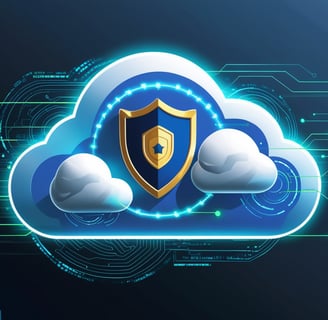Cloud Security
Cloud infrastructure has become essential for businesses and individuals alike, offering flexibility, scalability, and cost savings. However, ensuring this infrastructure is secure is critical, as any vulnerabilities can lead to data breaches, loss of sensitive information, or disruption of services. In this blog, we'll cover the key steps and best practices for building secure cloud infrastructure, explained in simple terms, so you can better protect your cloud-based assets.
CYBERSECURITY
Build Secure Cloud Infrastructure
Understand the Shared Responsibility Model
When using cloud services, security is a shared responsibility between you (the customer) and your cloud provider (like AWS, Google Cloud, or Azure).
Cloud Provider: Responsible for securing the cloud itself—this includes the physical security of the data centers, networking, and basic software infrastructure.
You (the customer): Responsible for securing what’s in the cloud—your data, applications, operating systems, and configuration settings.
Example :Think of it as renting a house: the landlord (cloud provider) secures the building, but you’re responsible for locking your doors and protecting your belongings.
Identity and Access Management (IAM)
Limit who can access what within your cloud environment.
Best Practice: Follow the "principle of least privilege," meaning users only get access to what they need to do their job. For example, a finance team member shouldn’t have access to the development environment.
Multi-Factor Authentication (MFA): Add an extra layer of security by requiring a second method of verifying identity (like a text code) along with a password.
Example: Imagine having a safe with a key (password), but also needing a fingerprint scan (MFA) to open it.
Secure Your Data (Encryption)
Encryption ensures that even if unauthorized people gain access to your data, they can’t read it.
Data at rest: Data stored on servers should be encrypted so it’s unreadable without the correct key.
Data in transit: Data moving between users, applications, and cloud services should also be encrypted (e.g., using HTTPS).
Example: Think of encryption as locking your data in a box that only you (or authorized users) have the key to.
Network Security
Just as you lock your home, you need to secure your cloud network to prevent unauthorized access.
Virtual Private Cloud (VPC): Create a private cloud network that only trusted devices can access.
Firewalls: Use firewalls to control traffic to and from your cloud resources. This prevents unwanted or malicious traffic from entering your cloud environment.
Example: A firewall is like a security guard that checks IDs at the door, ensuring only trusted people can enter.
Monitor and Log Everything
You need to track activity within your cloud infrastructure to detect unusual or unauthorized actions. Logging and monitoring help you spot potential security threats early.
Best Practice: Set up automated alerts for suspicious activities, like someone accessing sensitive data outside business hours.
Log Management: Use log files to store records of all activities in your cloud environment. These can help investigate security incidents.
Example: Think of this as having security cameras (logs) that record everything in and around your house. You can always go back and check the footage if something goes wrong.
Automate Security
Automating security tasks reduces the risk of human error and ensures consistent protection.
Automated Backups: Ensure regular backups of data are automatically taken, so you always have a recent copy if data is lost.
Infrastructure as Code (IaC): Write code to manage and configure your cloud infrastructure, allowing you to easily recreate your environment with security settings intact.
Example: Automating backups is like setting your phone to automatically save your photos to the cloud every night, so you don’t have to remember to do it manually.
Secure Applications and APIs
Cloud applications and APIs (Application Programming Interfaces) are vulnerable to attacks, especially if they aren’t properly secured.
Secure Development Practices: Use secure coding practices to prevent common vulnerabilities like SQL injection and cross-site scripting (XSS).
API Security: Ensure all APIs require authentication and only expose necessary information.
Example: It’s like putting locks on all the windows (APIs) in your house, so intruders can’t sneak in through open gaps.
Regular Vulnerability Assessments and Penetration Testing (VAPT)
Test your cloud infrastructure regularly to find and fix vulnerabilities before attackers can exploit them.
Vulnerability Assessment: Scan your systems for known weaknesses.
Penetration Testing: Hire professionals to simulate attacks on your infrastructure to find security holes.
Example: Think of VAPT as getting a professional to try breaking into your house to identify weak points you didn’t notice.
Ensure Compliance
Cloud security isn't just about protecting your data—it’s also about following laws and regulations, such as GDPR, HIPAA, or PCI-DSS, depending on your industry.
Best Practice: Know the legal requirements for your business, and ensure your cloud environment complies with them.
Audits: Conduct regular audits to ensure you remain compliant.
Example: It’s like ensuring your house meets local building codes to avoid penalties or legal trouble.
Incident Response Plan
No matter how secure your cloud infrastructure is, incidents can still happen. An incident response plan ensures you know what to do when something goes wrong.
Best Practice: Create a step-by-step plan for responding to security breaches, including who to contact and how to recover your systems.
Backup Recovery: Ensure your data backups are easily accessible and restorable in case of an attack.


